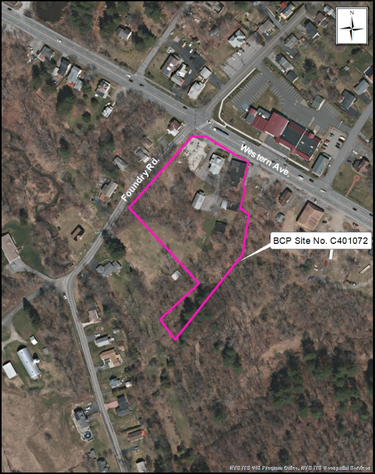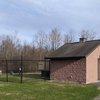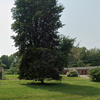DEC: More investigation to begin at Foundry Square brownfield site
— Map from NYSDEC
The 3.43-acre site outlined in fuschia will be investigated for contaminants. In 2019, a 0.43-acre site, just around the former Master Cleaners building, at the top right of the outline, was investigated where volatile organic compounds were found. The panhandle in the mapped study area looks to encompass an underground plume of pollutants that the DEC had determined earlier was traveling toward the Hunger Kill.
GUILDERLAND — Last Thursday, the town got word from the state’s Department of Environmental Conservation that further investigation will “soon resume” with the goal of ultimately cleaning the Foundry Road brownfield.
“I think it’s very important whenever you can get a brownfield cleaned up because the brownfield is by definition a threat to the environment …,” Supervisor Peter Barber told The Enterprise on Monday. “I’m glad that they’re making progress on it.”
The property to be investigated once housed a dry cleaners and a bus garage, facing Route 20. Those properties along with several others are now the site of a proposal for a large apartment complex at the corner of Western Avenue and Foundry Road.
The current owner of the property, Charles Bohl Inc., as well as the developer planning to buy the property to build the apartment complex, Guilderland Village LLC, are listed by the DEC as the applicants for the environmental investigation study.
In January, the Guilderland Town Board allowed the apartment project, named Foundry Square, to proceed to the planning board.
The planned unit development, with two massive four-story buildings housing a combined 260 apartments, is both denser and taller than allowed by town code. The 13 acres of land is spread across five separate tax parcels between 2298 and 2314 Western Ave. and is made up of a row of derelict buildings.
One of the key issues that eventually led the town board to allow the project to move forward was the developer’s statement that Guilderland Village would assume the $2 million cost for cleaning up the site.
Asked, in light of the April investigation notice, if the DEC would be shouldering some of the expense, Barber told The Enterprise, “I wish I knew the answer to that question. But my understanding of the way this works is that the DEC wants these brownfields to be cleaned up. And so they come up with a plan. And then usually the property owner or developer proposes how they’re going to go about doing it. And I think in return the brownfield cleanup program offers some tax benefits.”
Theresa Bohl, the majority shareholder of Charles Bohl Inc., which owns the property, had told the town board in December that she has been working for 13 years to clean up and sell the Route 20 properties.
She said her family’s company spent $1.3 million dollars in 2010 cleaning up the polluted gas-station site that is part of the property, and that she has also unsuccessfully tried auctioning off the parcels that are not polluted.
“Nobody will buy or develop a site that is next to a potential contaminated site,” Bohl said.
“We finally have a developer who has the will, the means, the determination, and the urgency to get this done,” said Bohl.
Three developers before have walked away from various proposals for the site, largely put off by the brownfield.
Investigation
A 2019 DEC investigation looked just at the 0.43-acre Master Cleaners site. The former dry-cleaning business, since abandoned, had operated from 1956 to 1996, the report said.
The Hunger Kill, located 600 feet southwest of the site, is the nearest surface water body, the report said.
The 2019 investigation found volatile organic compounds, known as VOCs, primarily consisting of chlorinated solvents used in dry-cleaning operations, in subsurface soils and groundwater at concentrations above use-specific soil cleanup objectives and groundwater standards.
“VOCs have a variety of direct and indirect impacts on people and the environment,” according to the National Institutes of Health, which goes on to list toxicity, carcinogenicity, stratospheric ozone depletion, and global climate change.
The Environmental Protection Agency notes that, as with other pollutants, the extent and nature of the health effect will depend on many factors including level of exposure to VOCs and length of time exposed.
The agency goes on to note health effects from exposure to VOCs can range from throat irritation, headaches, and nausea to liver, kidney, and central nervous system damage. It also states, “Some organics can cause cancer in animals, some are suspected or known to cause cancer in humans.”
“Chlorinated solvents are present in soil and groundwater at depths up to 15 feet below grade,” the 2019 DEC report said. “Groundwater is present at shallow depths ranging from 1 to 6 feet below grade depending on the season and location. There is a distinct confining clay layer at the site ranging from 11 to 15 feet below grade that appears to be limiting the vertical migration of contaminants.”
The 2025 investigation will cover a much larger site, including both the Master Cleaners property at 2312 Western Avenue as well as the neighboring property at 2314 Western Ave., which was formerly used for automotive repair and as a bus garage.
The 2025 investigation fact sheet describes the 3.43-acre site this way: “The northern portion of the site consists of an abandoned former dry-cleaner building, a storage barn, a vacant house, a vacant apartment building and the concrete slab/foundation of a former bus garage.
“The southern portion of the site is wooded with a storm water discharge and a small tributary along the eastern edge of the site which discharges to the Hunger Kill approximately 600 feet south of the site.”
The panhandle in the mapped study area looks to encompass an underground plume of pollutants that the DEC had determined earlier was traveling toward the Hunger Kill.
The current report goes on to state, “The investigation will define the nature and extent of contamination in soil, soil vapor, groundwater and any other parts of the environment that may be affected.”
Techniques to be used include installing and sampling soil borings to identify possible on-site sources of contamination; collecting soil vapor samples; and installing and sampling groundwater wells to monitor impacts from areas of concern.
The DEC notes that past investigation at the site found chlorinated solvent contamination with tetrachloroethene (PCE), a contaminate often associated with dry-cleaning, and its byproducts present in the site’s subsurface.
Among VOCs, trichloroethylene and vinyl chloride are the most toxic and carcinogenic compounds, according to the National Institutes of Health.
Once the investigation is completed, a report summarizing results will be submitted to the DEC for review.
The DEC will revise where necessary before approving the report. A cleanup plan will be developed with the goal of ensuring “the protection of public health and the environment,” which the DEC will present to the public. This is to be followed by a 45-day period for public comment.
Developer’s plan
Jeffrey Marx, an environmental engineer with C.T. Male Associates, had told the town board on Jan. 7 that the developer’s plan is to remove the contaminated soil at the former Master Cleaners site — “get that problem out of there and away,” he said.
Depending on the toxicity of the soil, it will be burned at a facility that reclaims the soil or it will be shipped to a landfill out of state used for such materials.
But other “remedial action” will be needed, he said, to deal with the plume of contaminants that continues to spread from the original site.
“That remedial action work plan will have a fact sheet, will have a public-comment period, and, if necessary, if there’s enough involvement from the community, there would be a public meeting,” said Marx, stating the air will be monitored throughout.
The goal is to obtain a “certificate of completion” from the state.
“We don’t just walk away at that point,” said Marx, explaining that a site-managament plan is tied to the deed of the property.
The monitoring continues until groundwater standards are met, said Marx, which could range from a year to decades.
Pollutants that have migrated outside the boundaries of the property fall under the purview of the DEC to clean up, he said.



